Developing a Curriculum on Aboriginality for Young Children
VerifiedAdded on 2021/04/21
|13
|2868
|150
Homework Assignment
AI Summary
This assignment presents a curriculum plan designed for early childhood education, focusing on the theme of Aboriginality. It outlines three key learning objectives: fostering a strong sense of identity, connecting children with the real world, and developing effective communication skills. The curriculum incorporates various activities and resources to achieve these objectives, including video shows, colored eggs, role-playing, and discussions. The rationale emphasizes the importance of multicultural learning environments and the need for children to feel comfortable with their identities. The assignment also highlights the significance of outdoor activities, communication skills, and the role of teachers in creating a supportive learning environment. Professional reflection is included, discussing the impact of the learning outcomes on young learners, the importance of engaging children in critical thinking, and the need to consider cultural diversities in teaching. The curriculum references both the EYLF (Early Years Learning Framework) and NQS (National Quality Standard) frameworks to ensure alignment with educational standards. The document is contributed by a student to be published on the website Desklib, a platform which provides all the necessary AI based study tools for students.
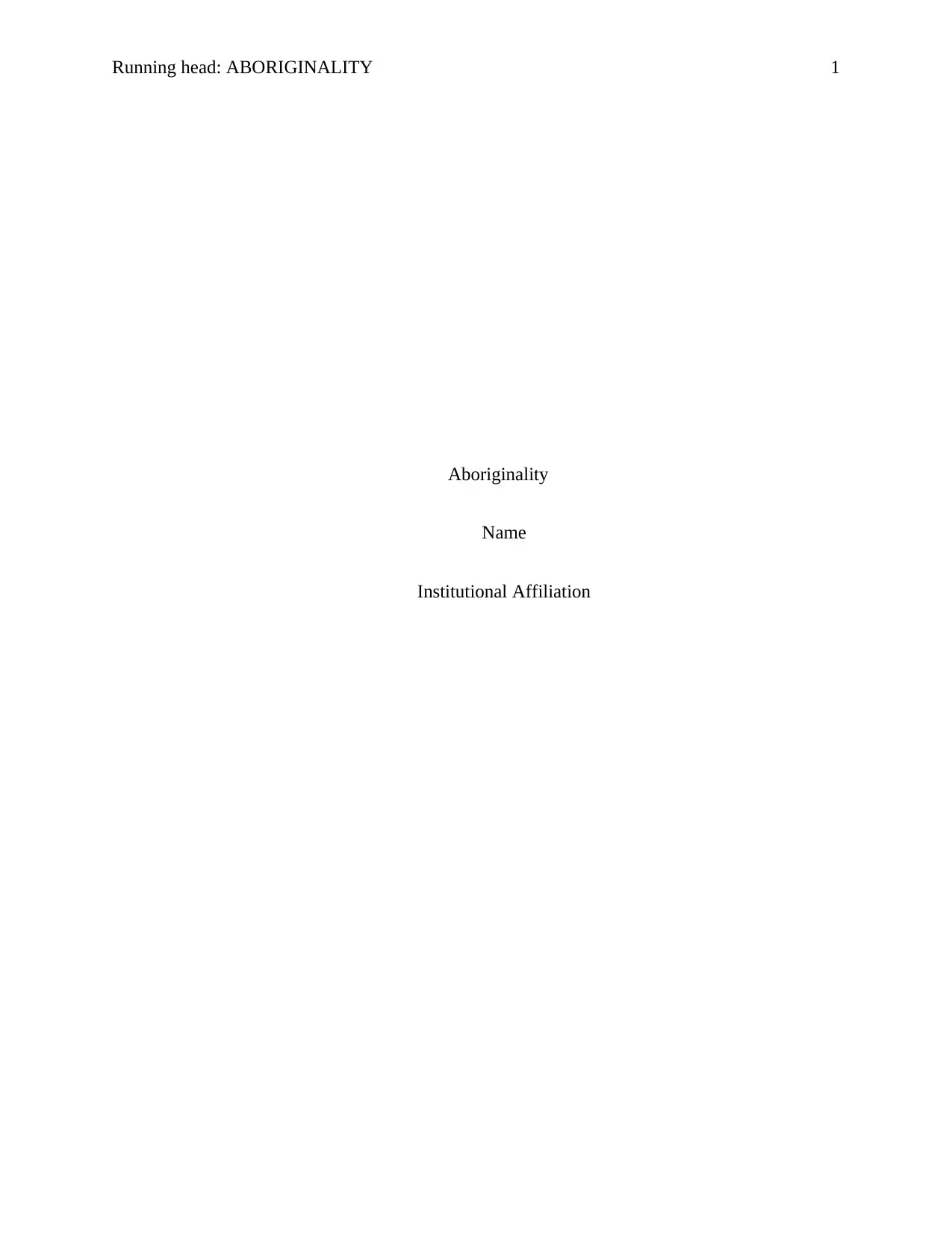
Running head: ABORIGINALITY 1
Aboriginality
Name
Institutional Affiliation
Aboriginality
Name
Institutional Affiliation
Paraphrase This Document
Need a fresh take? Get an instant paraphrase of this document with our AI Paraphraser
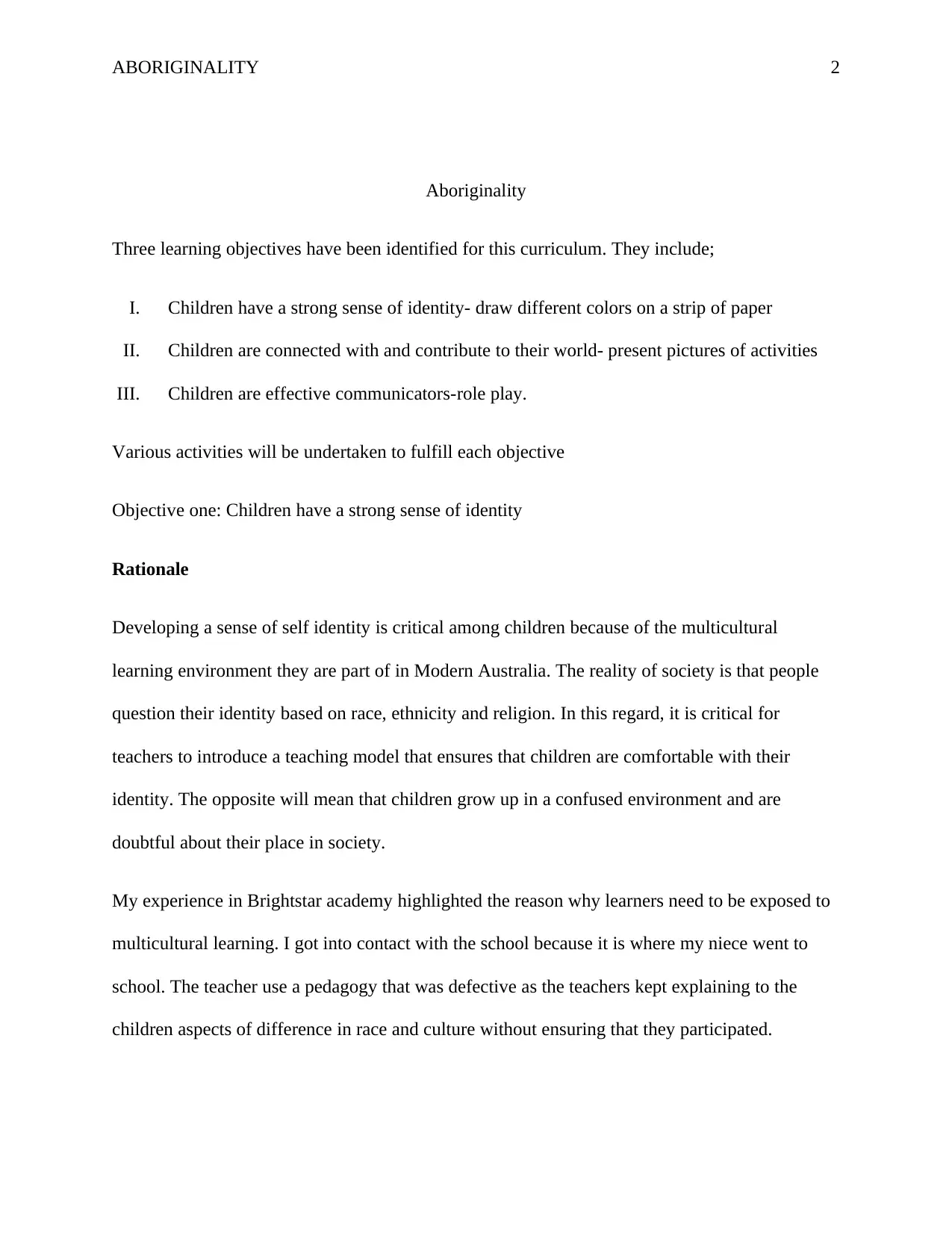
ABORIGINALITY 2
Aboriginality
Three learning objectives have been identified for this curriculum. They include;
I. Children have a strong sense of identity- draw different colors on a strip of paper
II. Children are connected with and contribute to their world- present pictures of activities
III. Children are effective communicators-role play.
Various activities will be undertaken to fulfill each objective
Objective one: Children have a strong sense of identity
Rationale
Developing a sense of self identity is critical among children because of the multicultural
learning environment they are part of in Modern Australia. The reality of society is that people
question their identity based on race, ethnicity and religion. In this regard, it is critical for
teachers to introduce a teaching model that ensures that children are comfortable with their
identity. The opposite will mean that children grow up in a confused environment and are
doubtful about their place in society.
My experience in Brightstar academy highlighted the reason why learners need to be exposed to
multicultural learning. I got into contact with the school because it is where my niece went to
school. The teacher use a pedagogy that was defective as the teachers kept explaining to the
children aspects of difference in race and culture without ensuring that they participated.
Aboriginality
Three learning objectives have been identified for this curriculum. They include;
I. Children have a strong sense of identity- draw different colors on a strip of paper
II. Children are connected with and contribute to their world- present pictures of activities
III. Children are effective communicators-role play.
Various activities will be undertaken to fulfill each objective
Objective one: Children have a strong sense of identity
Rationale
Developing a sense of self identity is critical among children because of the multicultural
learning environment they are part of in Modern Australia. The reality of society is that people
question their identity based on race, ethnicity and religion. In this regard, it is critical for
teachers to introduce a teaching model that ensures that children are comfortable with their
identity. The opposite will mean that children grow up in a confused environment and are
doubtful about their place in society.
My experience in Brightstar academy highlighted the reason why learners need to be exposed to
multicultural learning. I got into contact with the school because it is where my niece went to
school. The teacher use a pedagogy that was defective as the teachers kept explaining to the
children aspects of difference in race and culture without ensuring that they participated.
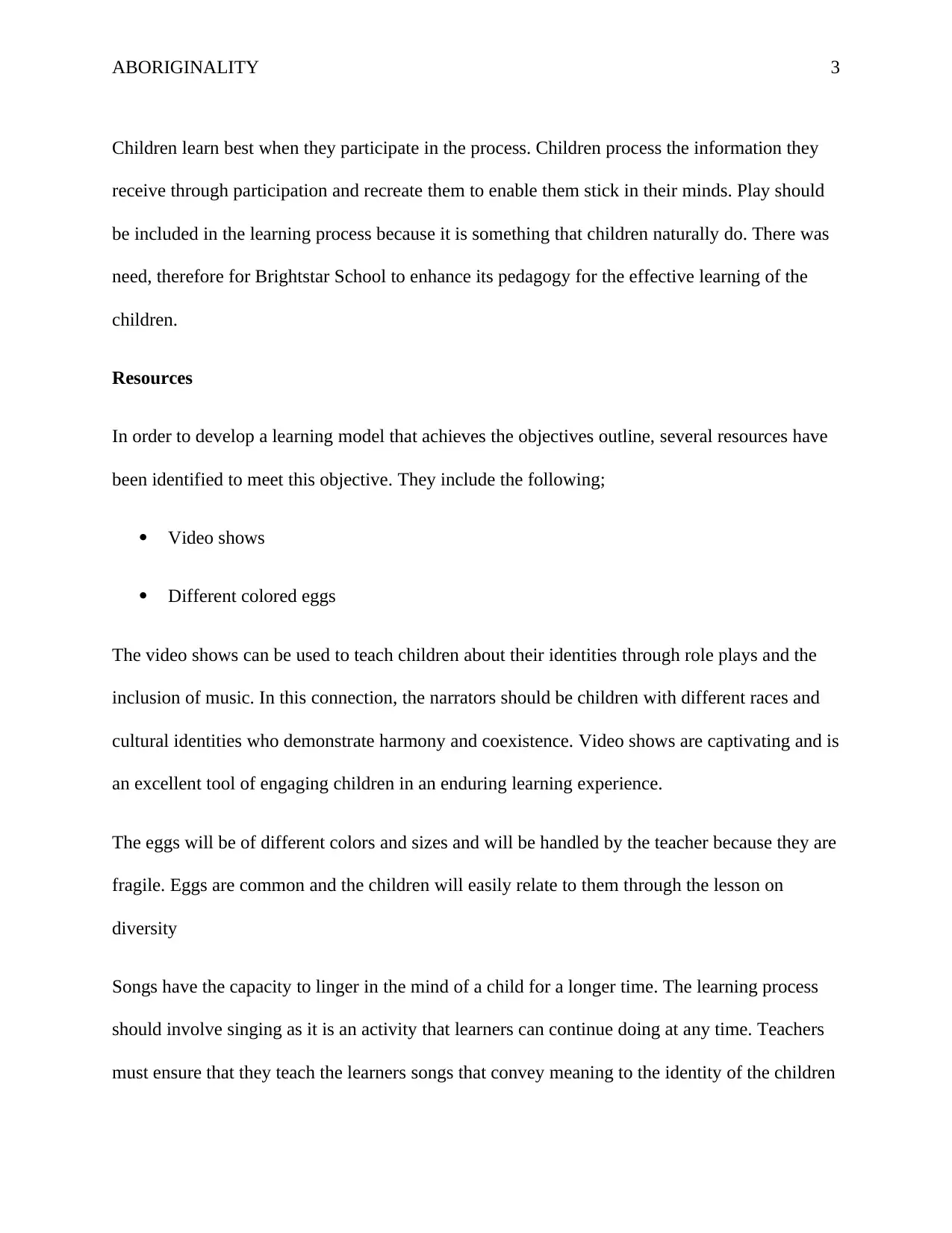
ABORIGINALITY 3
Children learn best when they participate in the process. Children process the information they
receive through participation and recreate them to enable them stick in their minds. Play should
be included in the learning process because it is something that children naturally do. There was
need, therefore for Brightstar School to enhance its pedagogy for the effective learning of the
children.
Resources
In order to develop a learning model that achieves the objectives outline, several resources have
been identified to meet this objective. They include the following;
Video shows
Different colored eggs
The video shows can be used to teach children about their identities through role plays and the
inclusion of music. In this connection, the narrators should be children with different races and
cultural identities who demonstrate harmony and coexistence. Video shows are captivating and is
an excellent tool of engaging children in an enduring learning experience.
The eggs will be of different colors and sizes and will be handled by the teacher because they are
fragile. Eggs are common and the children will easily relate to them through the lesson on
diversity
Songs have the capacity to linger in the mind of a child for a longer time. The learning process
should involve singing as it is an activity that learners can continue doing at any time. Teachers
must ensure that they teach the learners songs that convey meaning to the identity of the children
Children learn best when they participate in the process. Children process the information they
receive through participation and recreate them to enable them stick in their minds. Play should
be included in the learning process because it is something that children naturally do. There was
need, therefore for Brightstar School to enhance its pedagogy for the effective learning of the
children.
Resources
In order to develop a learning model that achieves the objectives outline, several resources have
been identified to meet this objective. They include the following;
Video shows
Different colored eggs
The video shows can be used to teach children about their identities through role plays and the
inclusion of music. In this connection, the narrators should be children with different races and
cultural identities who demonstrate harmony and coexistence. Video shows are captivating and is
an excellent tool of engaging children in an enduring learning experience.
The eggs will be of different colors and sizes and will be handled by the teacher because they are
fragile. Eggs are common and the children will easily relate to them through the lesson on
diversity
Songs have the capacity to linger in the mind of a child for a longer time. The learning process
should involve singing as it is an activity that learners can continue doing at any time. Teachers
must ensure that they teach the learners songs that convey meaning to the identity of the children
⊘ This is a preview!⊘
Do you want full access?
Subscribe today to unlock all pages.

Trusted by 1+ million students worldwide
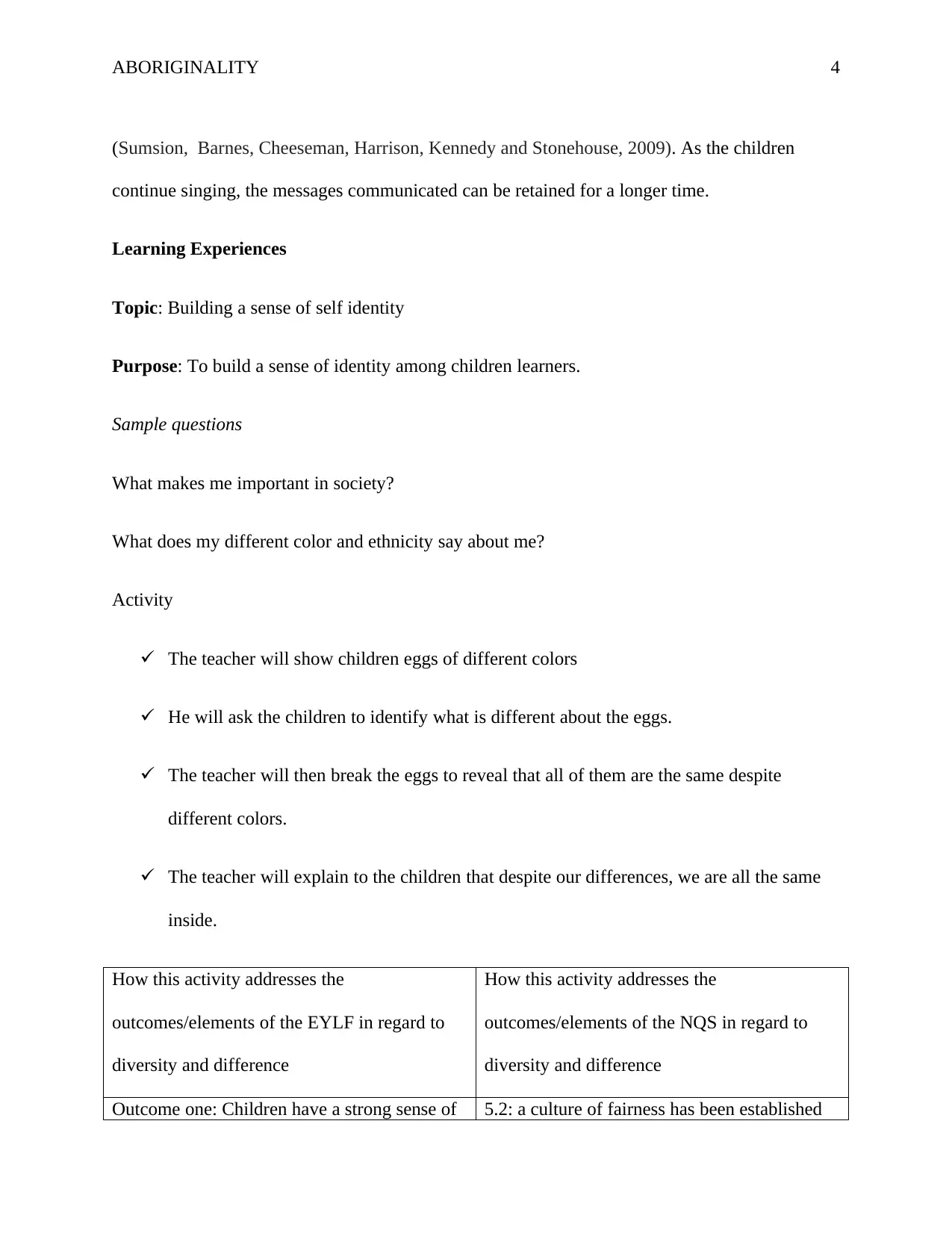
ABORIGINALITY 4
(Sumsion, Barnes, Cheeseman, Harrison, Kennedy and Stonehouse, 2009). As the children
continue singing, the messages communicated can be retained for a longer time.
Learning Experiences
Topic: Building a sense of self identity
Purpose: To build a sense of identity among children learners.
Sample questions
What makes me important in society?
What does my different color and ethnicity say about me?
Activity
The teacher will show children eggs of different colors
He will ask the children to identify what is different about the eggs.
The teacher will then break the eggs to reveal that all of them are the same despite
different colors.
The teacher will explain to the children that despite our differences, we are all the same
inside.
How this activity addresses the
outcomes/elements of the EYLF in regard to
diversity and difference
How this activity addresses the
outcomes/elements of the NQS in regard to
diversity and difference
Outcome one: Children have a strong sense of 5.2: a culture of fairness has been established
(Sumsion, Barnes, Cheeseman, Harrison, Kennedy and Stonehouse, 2009). As the children
continue singing, the messages communicated can be retained for a longer time.
Learning Experiences
Topic: Building a sense of self identity
Purpose: To build a sense of identity among children learners.
Sample questions
What makes me important in society?
What does my different color and ethnicity say about me?
Activity
The teacher will show children eggs of different colors
He will ask the children to identify what is different about the eggs.
The teacher will then break the eggs to reveal that all of them are the same despite
different colors.
The teacher will explain to the children that despite our differences, we are all the same
inside.
How this activity addresses the
outcomes/elements of the EYLF in regard to
diversity and difference
How this activity addresses the
outcomes/elements of the NQS in regard to
diversity and difference
Outcome one: Children have a strong sense of 5.2: a culture of fairness has been established
Paraphrase This Document
Need a fresh take? Get an instant paraphrase of this document with our AI Paraphraser
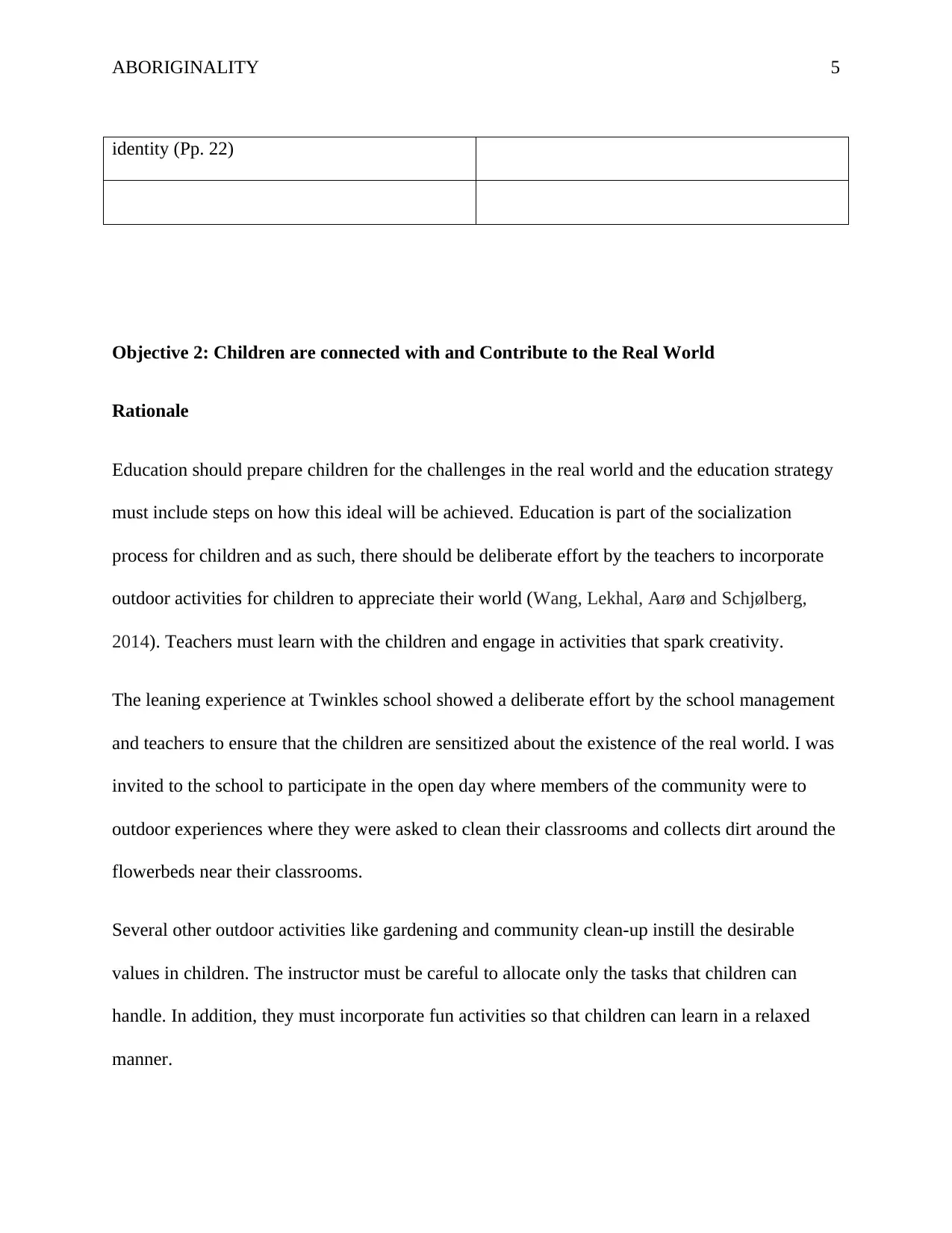
ABORIGINALITY 5
identity (Pp. 22)
Objective 2: Children are connected with and Contribute to the Real World
Rationale
Education should prepare children for the challenges in the real world and the education strategy
must include steps on how this ideal will be achieved. Education is part of the socialization
process for children and as such, there should be deliberate effort by the teachers to incorporate
outdoor activities for children to appreciate their world (Wang, Lekhal, Aarø and Schjølberg,
2014). Teachers must learn with the children and engage in activities that spark creativity.
The leaning experience at Twinkles school showed a deliberate effort by the school management
and teachers to ensure that the children are sensitized about the existence of the real world. I was
invited to the school to participate in the open day where members of the community were to
outdoor experiences where they were asked to clean their classrooms and collects dirt around the
flowerbeds near their classrooms.
Several other outdoor activities like gardening and community clean-up instill the desirable
values in children. The instructor must be careful to allocate only the tasks that children can
handle. In addition, they must incorporate fun activities so that children can learn in a relaxed
manner.
identity (Pp. 22)
Objective 2: Children are connected with and Contribute to the Real World
Rationale
Education should prepare children for the challenges in the real world and the education strategy
must include steps on how this ideal will be achieved. Education is part of the socialization
process for children and as such, there should be deliberate effort by the teachers to incorporate
outdoor activities for children to appreciate their world (Wang, Lekhal, Aarø and Schjølberg,
2014). Teachers must learn with the children and engage in activities that spark creativity.
The leaning experience at Twinkles school showed a deliberate effort by the school management
and teachers to ensure that the children are sensitized about the existence of the real world. I was
invited to the school to participate in the open day where members of the community were to
outdoor experiences where they were asked to clean their classrooms and collects dirt around the
flowerbeds near their classrooms.
Several other outdoor activities like gardening and community clean-up instill the desirable
values in children. The instructor must be careful to allocate only the tasks that children can
handle. In addition, they must incorporate fun activities so that children can learn in a relaxed
manner.
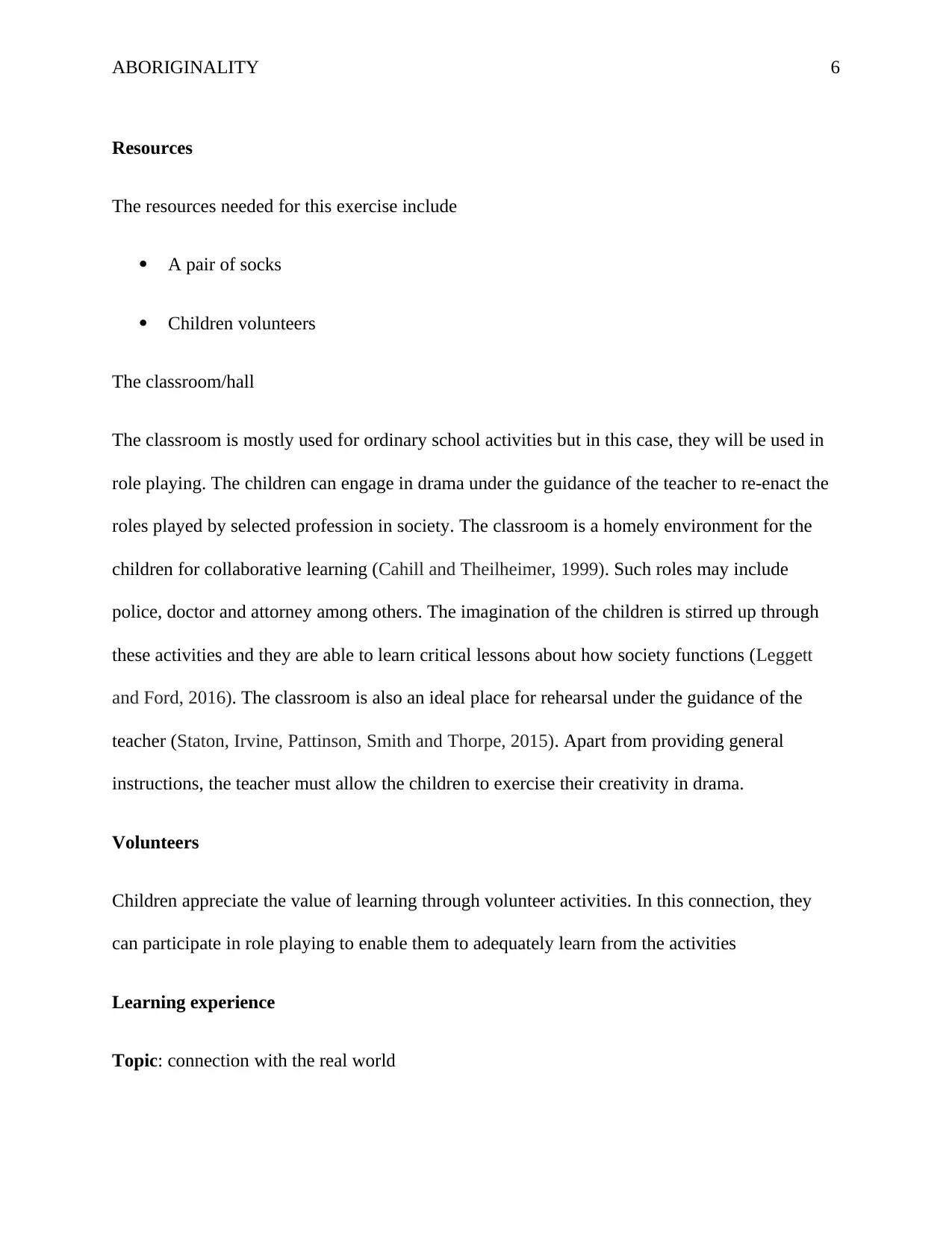
ABORIGINALITY 6
Resources
The resources needed for this exercise include
A pair of socks
Children volunteers
The classroom/hall
The classroom is mostly used for ordinary school activities but in this case, they will be used in
role playing. The children can engage in drama under the guidance of the teacher to re-enact the
roles played by selected profession in society. The classroom is a homely environment for the
children for collaborative learning (Cahill and Theilheimer, 1999). Such roles may include
police, doctor and attorney among others. The imagination of the children is stirred up through
these activities and they are able to learn critical lessons about how society functions (Leggett
and Ford, 2016). The classroom is also an ideal place for rehearsal under the guidance of the
teacher (Staton, Irvine, Pattinson, Smith and Thorpe, 2015). Apart from providing general
instructions, the teacher must allow the children to exercise their creativity in drama.
Volunteers
Children appreciate the value of learning through volunteer activities. In this connection, they
can participate in role playing to enable them to adequately learn from the activities
Learning experience
Topic: connection with the real world
Resources
The resources needed for this exercise include
A pair of socks
Children volunteers
The classroom/hall
The classroom is mostly used for ordinary school activities but in this case, they will be used in
role playing. The children can engage in drama under the guidance of the teacher to re-enact the
roles played by selected profession in society. The classroom is a homely environment for the
children for collaborative learning (Cahill and Theilheimer, 1999). Such roles may include
police, doctor and attorney among others. The imagination of the children is stirred up through
these activities and they are able to learn critical lessons about how society functions (Leggett
and Ford, 2016). The classroom is also an ideal place for rehearsal under the guidance of the
teacher (Staton, Irvine, Pattinson, Smith and Thorpe, 2015). Apart from providing general
instructions, the teacher must allow the children to exercise their creativity in drama.
Volunteers
Children appreciate the value of learning through volunteer activities. In this connection, they
can participate in role playing to enable them to adequately learn from the activities
Learning experience
Topic: connection with the real world
⊘ This is a preview!⊘
Do you want full access?
Subscribe today to unlock all pages.

Trusted by 1+ million students worldwide
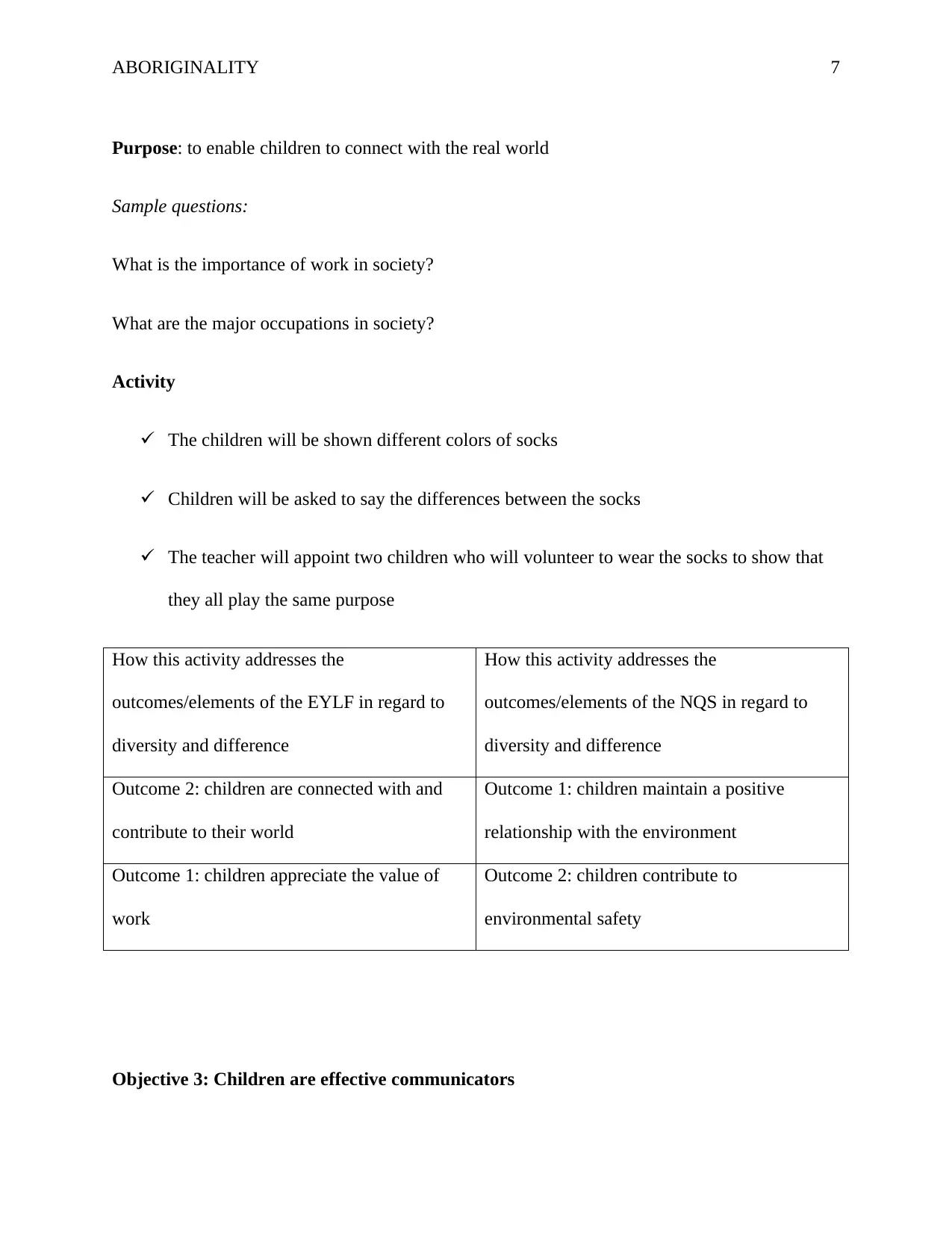
ABORIGINALITY 7
Purpose: to enable children to connect with the real world
Sample questions:
What is the importance of work in society?
What are the major occupations in society?
Activity
The children will be shown different colors of socks
Children will be asked to say the differences between the socks
The teacher will appoint two children who will volunteer to wear the socks to show that
they all play the same purpose
How this activity addresses the
outcomes/elements of the EYLF in regard to
diversity and difference
How this activity addresses the
outcomes/elements of the NQS in regard to
diversity and difference
Outcome 2: children are connected with and
contribute to their world
Outcome 1: children maintain a positive
relationship with the environment
Outcome 1: children appreciate the value of
work
Outcome 2: children contribute to
environmental safety
Objective 3: Children are effective communicators
Purpose: to enable children to connect with the real world
Sample questions:
What is the importance of work in society?
What are the major occupations in society?
Activity
The children will be shown different colors of socks
Children will be asked to say the differences between the socks
The teacher will appoint two children who will volunteer to wear the socks to show that
they all play the same purpose
How this activity addresses the
outcomes/elements of the EYLF in regard to
diversity and difference
How this activity addresses the
outcomes/elements of the NQS in regard to
diversity and difference
Outcome 2: children are connected with and
contribute to their world
Outcome 1: children maintain a positive
relationship with the environment
Outcome 1: children appreciate the value of
work
Outcome 2: children contribute to
environmental safety
Objective 3: Children are effective communicators
Paraphrase This Document
Need a fresh take? Get an instant paraphrase of this document with our AI Paraphraser
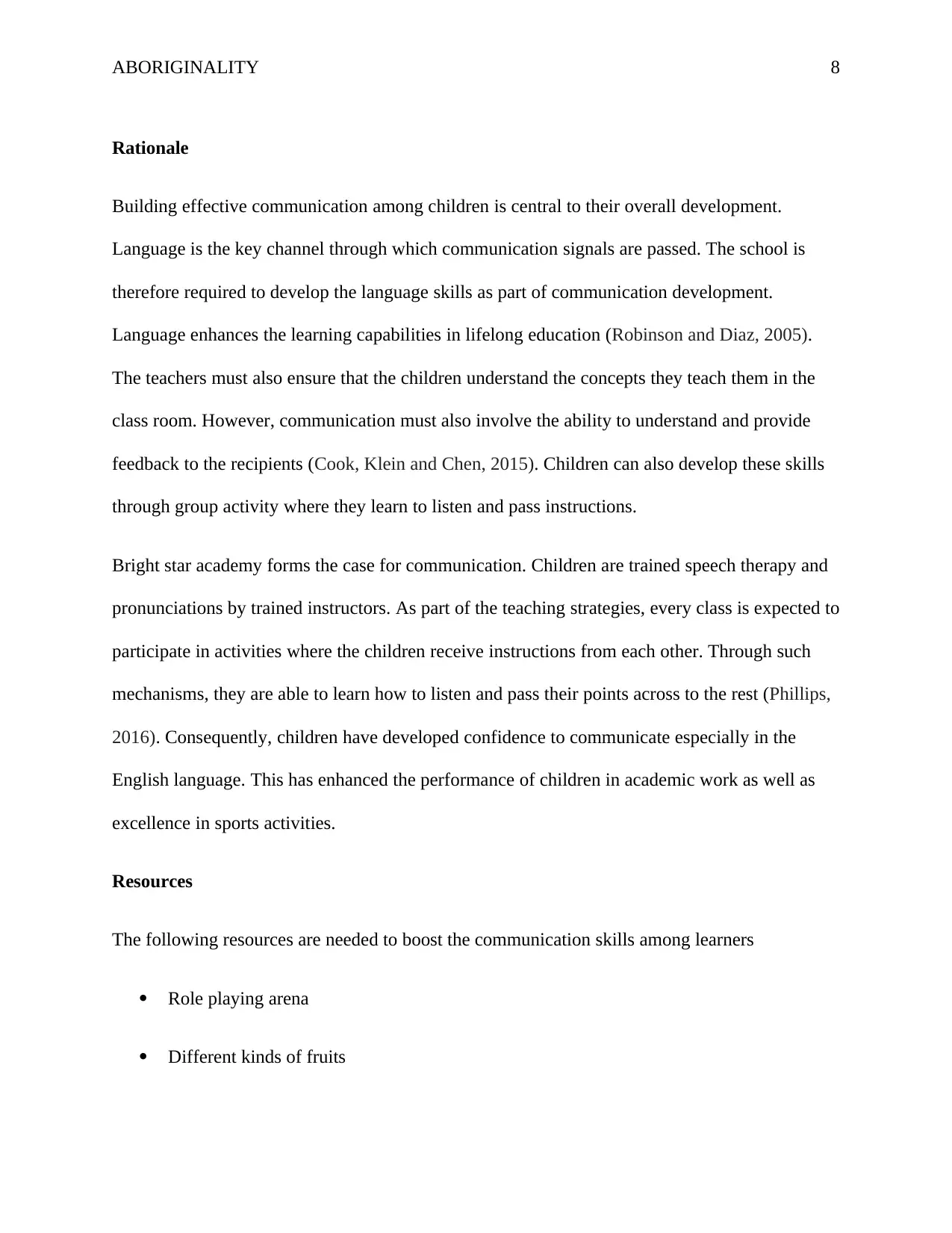
ABORIGINALITY 8
Rationale
Building effective communication among children is central to their overall development.
Language is the key channel through which communication signals are passed. The school is
therefore required to develop the language skills as part of communication development.
Language enhances the learning capabilities in lifelong education (Robinson and Diaz, 2005).
The teachers must also ensure that the children understand the concepts they teach them in the
class room. However, communication must also involve the ability to understand and provide
feedback to the recipients (Cook, Klein and Chen, 2015). Children can also develop these skills
through group activity where they learn to listen and pass instructions.
Bright star academy forms the case for communication. Children are trained speech therapy and
pronunciations by trained instructors. As part of the teaching strategies, every class is expected to
participate in activities where the children receive instructions from each other. Through such
mechanisms, they are able to learn how to listen and pass their points across to the rest (Phillips,
2016). Consequently, children have developed confidence to communicate especially in the
English language. This has enhanced the performance of children in academic work as well as
excellence in sports activities.
Resources
The following resources are needed to boost the communication skills among learners
Role playing arena
Different kinds of fruits
Rationale
Building effective communication among children is central to their overall development.
Language is the key channel through which communication signals are passed. The school is
therefore required to develop the language skills as part of communication development.
Language enhances the learning capabilities in lifelong education (Robinson and Diaz, 2005).
The teachers must also ensure that the children understand the concepts they teach them in the
class room. However, communication must also involve the ability to understand and provide
feedback to the recipients (Cook, Klein and Chen, 2015). Children can also develop these skills
through group activity where they learn to listen and pass instructions.
Bright star academy forms the case for communication. Children are trained speech therapy and
pronunciations by trained instructors. As part of the teaching strategies, every class is expected to
participate in activities where the children receive instructions from each other. Through such
mechanisms, they are able to learn how to listen and pass their points across to the rest (Phillips,
2016). Consequently, children have developed confidence to communicate especially in the
English language. This has enhanced the performance of children in academic work as well as
excellence in sports activities.
Resources
The following resources are needed to boost the communication skills among learners
Role playing arena
Different kinds of fruits
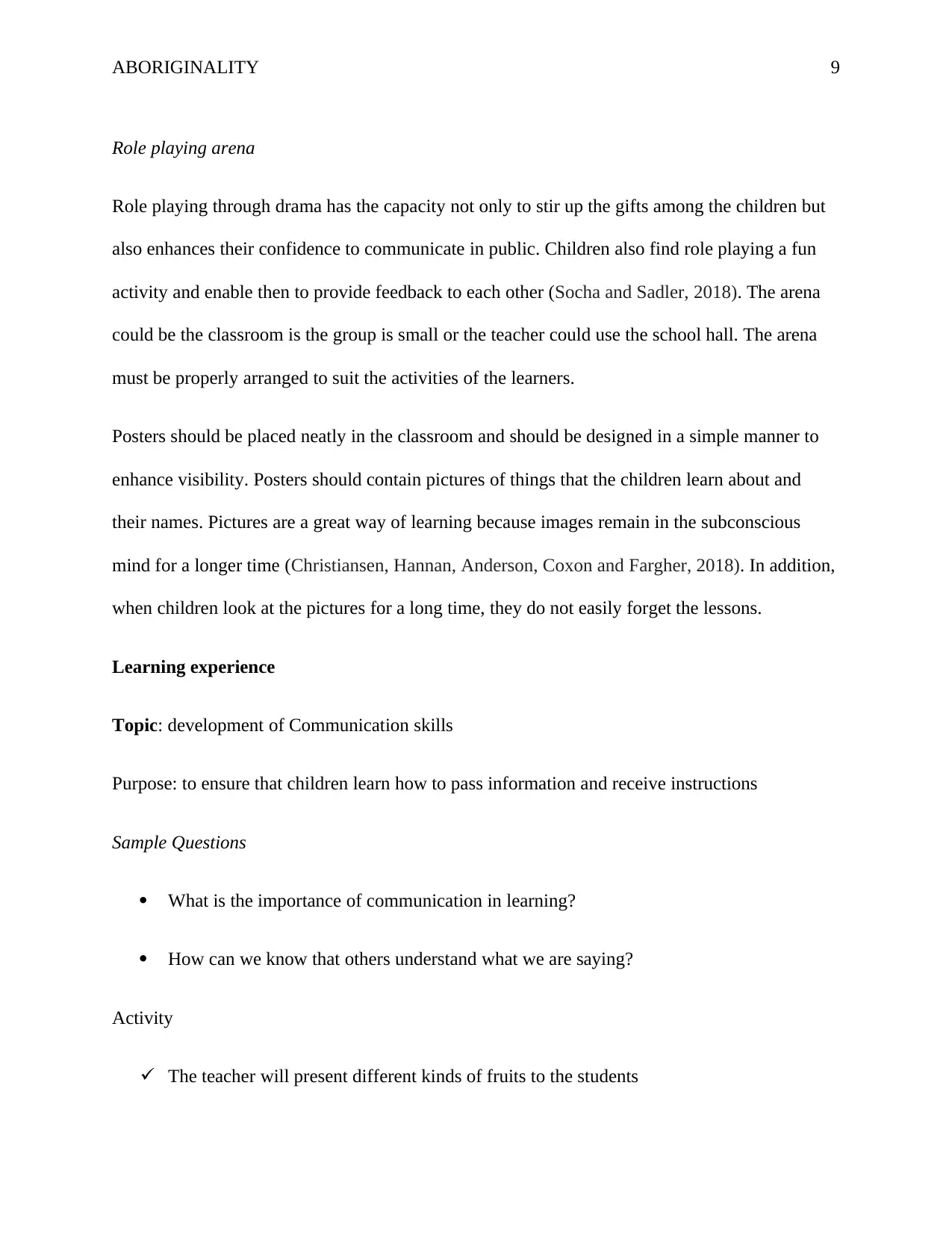
ABORIGINALITY 9
Role playing arena
Role playing through drama has the capacity not only to stir up the gifts among the children but
also enhances their confidence to communicate in public. Children also find role playing a fun
activity and enable then to provide feedback to each other (Socha and Sadler, 2018). The arena
could be the classroom is the group is small or the teacher could use the school hall. The arena
must be properly arranged to suit the activities of the learners.
Posters should be placed neatly in the classroom and should be designed in a simple manner to
enhance visibility. Posters should contain pictures of things that the children learn about and
their names. Pictures are a great way of learning because images remain in the subconscious
mind for a longer time (Christiansen, Hannan, Anderson, Coxon and Fargher, 2018). In addition,
when children look at the pictures for a long time, they do not easily forget the lessons.
Learning experience
Topic: development of Communication skills
Purpose: to ensure that children learn how to pass information and receive instructions
Sample Questions
What is the importance of communication in learning?
How can we know that others understand what we are saying?
Activity
The teacher will present different kinds of fruits to the students
Role playing arena
Role playing through drama has the capacity not only to stir up the gifts among the children but
also enhances their confidence to communicate in public. Children also find role playing a fun
activity and enable then to provide feedback to each other (Socha and Sadler, 2018). The arena
could be the classroom is the group is small or the teacher could use the school hall. The arena
must be properly arranged to suit the activities of the learners.
Posters should be placed neatly in the classroom and should be designed in a simple manner to
enhance visibility. Posters should contain pictures of things that the children learn about and
their names. Pictures are a great way of learning because images remain in the subconscious
mind for a longer time (Christiansen, Hannan, Anderson, Coxon and Fargher, 2018). In addition,
when children look at the pictures for a long time, they do not easily forget the lessons.
Learning experience
Topic: development of Communication skills
Purpose: to ensure that children learn how to pass information and receive instructions
Sample Questions
What is the importance of communication in learning?
How can we know that others understand what we are saying?
Activity
The teacher will present different kinds of fruits to the students
⊘ This is a preview!⊘
Do you want full access?
Subscribe today to unlock all pages.

Trusted by 1+ million students worldwide
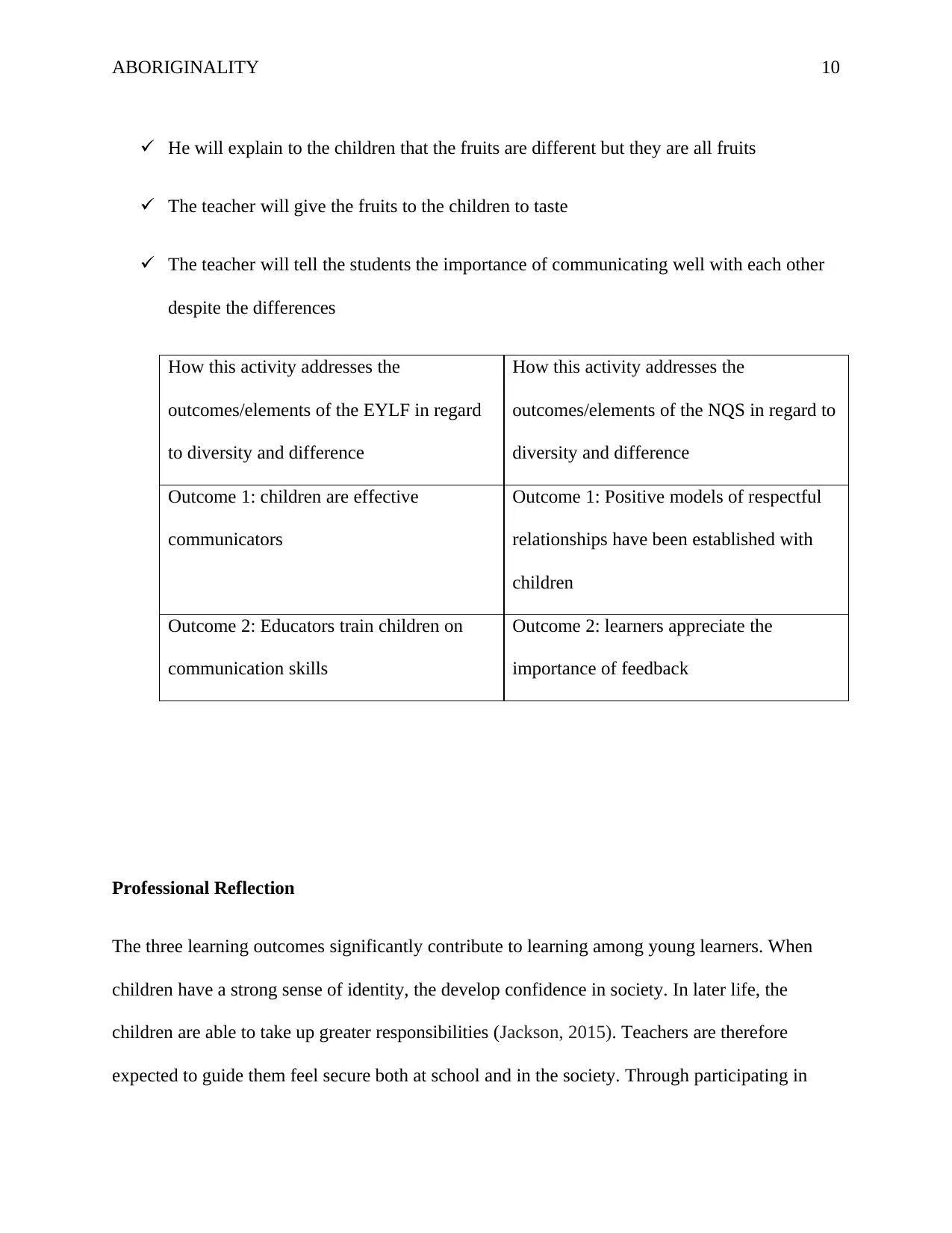
ABORIGINALITY 10
He will explain to the children that the fruits are different but they are all fruits
The teacher will give the fruits to the children to taste
The teacher will tell the students the importance of communicating well with each other
despite the differences
How this activity addresses the
outcomes/elements of the EYLF in regard
to diversity and difference
How this activity addresses the
outcomes/elements of the NQS in regard to
diversity and difference
Outcome 1: children are effective
communicators
Outcome 1: Positive models of respectful
relationships have been established with
children
Outcome 2: Educators train children on
communication skills
Outcome 2: learners appreciate the
importance of feedback
Professional Reflection
The three learning outcomes significantly contribute to learning among young learners. When
children have a strong sense of identity, the develop confidence in society. In later life, the
children are able to take up greater responsibilities (Jackson, 2015). Teachers are therefore
expected to guide them feel secure both at school and in the society. Through participating in
He will explain to the children that the fruits are different but they are all fruits
The teacher will give the fruits to the children to taste
The teacher will tell the students the importance of communicating well with each other
despite the differences
How this activity addresses the
outcomes/elements of the EYLF in regard
to diversity and difference
How this activity addresses the
outcomes/elements of the NQS in regard to
diversity and difference
Outcome 1: children are effective
communicators
Outcome 1: Positive models of respectful
relationships have been established with
children
Outcome 2: Educators train children on
communication skills
Outcome 2: learners appreciate the
importance of feedback
Professional Reflection
The three learning outcomes significantly contribute to learning among young learners. When
children have a strong sense of identity, the develop confidence in society. In later life, the
children are able to take up greater responsibilities (Jackson, 2015). Teachers are therefore
expected to guide them feel secure both at school and in the society. Through participating in
Paraphrase This Document
Need a fresh take? Get an instant paraphrase of this document with our AI Paraphraser
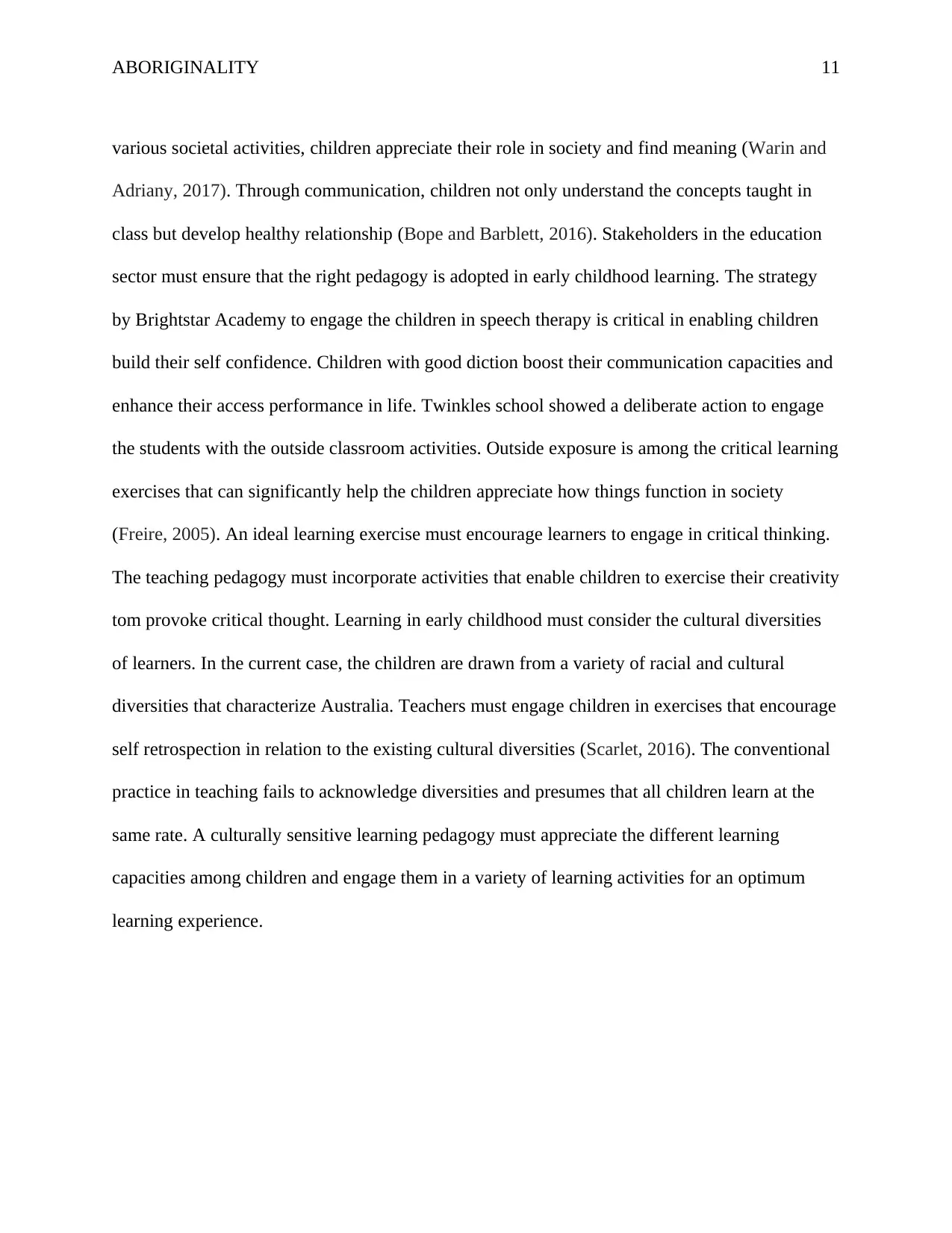
ABORIGINALITY 11
various societal activities, children appreciate their role in society and find meaning (Warin and
Adriany, 2017). Through communication, children not only understand the concepts taught in
class but develop healthy relationship (Bope and Barblett, 2016). Stakeholders in the education
sector must ensure that the right pedagogy is adopted in early childhood learning. The strategy
by Brightstar Academy to engage the children in speech therapy is critical in enabling children
build their self confidence. Children with good diction boost their communication capacities and
enhance their access performance in life. Twinkles school showed a deliberate action to engage
the students with the outside classroom activities. Outside exposure is among the critical learning
exercises that can significantly help the children appreciate how things function in society
(Freire, 2005). An ideal learning exercise must encourage learners to engage in critical thinking.
The teaching pedagogy must incorporate activities that enable children to exercise their creativity
tom provoke critical thought. Learning in early childhood must consider the cultural diversities
of learners. In the current case, the children are drawn from a variety of racial and cultural
diversities that characterize Australia. Teachers must engage children in exercises that encourage
self retrospection in relation to the existing cultural diversities (Scarlet, 2016). The conventional
practice in teaching fails to acknowledge diversities and presumes that all children learn at the
same rate. A culturally sensitive learning pedagogy must appreciate the different learning
capacities among children and engage them in a variety of learning activities for an optimum
learning experience.
various societal activities, children appreciate their role in society and find meaning (Warin and
Adriany, 2017). Through communication, children not only understand the concepts taught in
class but develop healthy relationship (Bope and Barblett, 2016). Stakeholders in the education
sector must ensure that the right pedagogy is adopted in early childhood learning. The strategy
by Brightstar Academy to engage the children in speech therapy is critical in enabling children
build their self confidence. Children with good diction boost their communication capacities and
enhance their access performance in life. Twinkles school showed a deliberate action to engage
the students with the outside classroom activities. Outside exposure is among the critical learning
exercises that can significantly help the children appreciate how things function in society
(Freire, 2005). An ideal learning exercise must encourage learners to engage in critical thinking.
The teaching pedagogy must incorporate activities that enable children to exercise their creativity
tom provoke critical thought. Learning in early childhood must consider the cultural diversities
of learners. In the current case, the children are drawn from a variety of racial and cultural
diversities that characterize Australia. Teachers must engage children in exercises that encourage
self retrospection in relation to the existing cultural diversities (Scarlet, 2016). The conventional
practice in teaching fails to acknowledge diversities and presumes that all children learn at the
same rate. A culturally sensitive learning pedagogy must appreciate the different learning
capacities among children and engage them in a variety of learning activities for an optimum
learning experience.
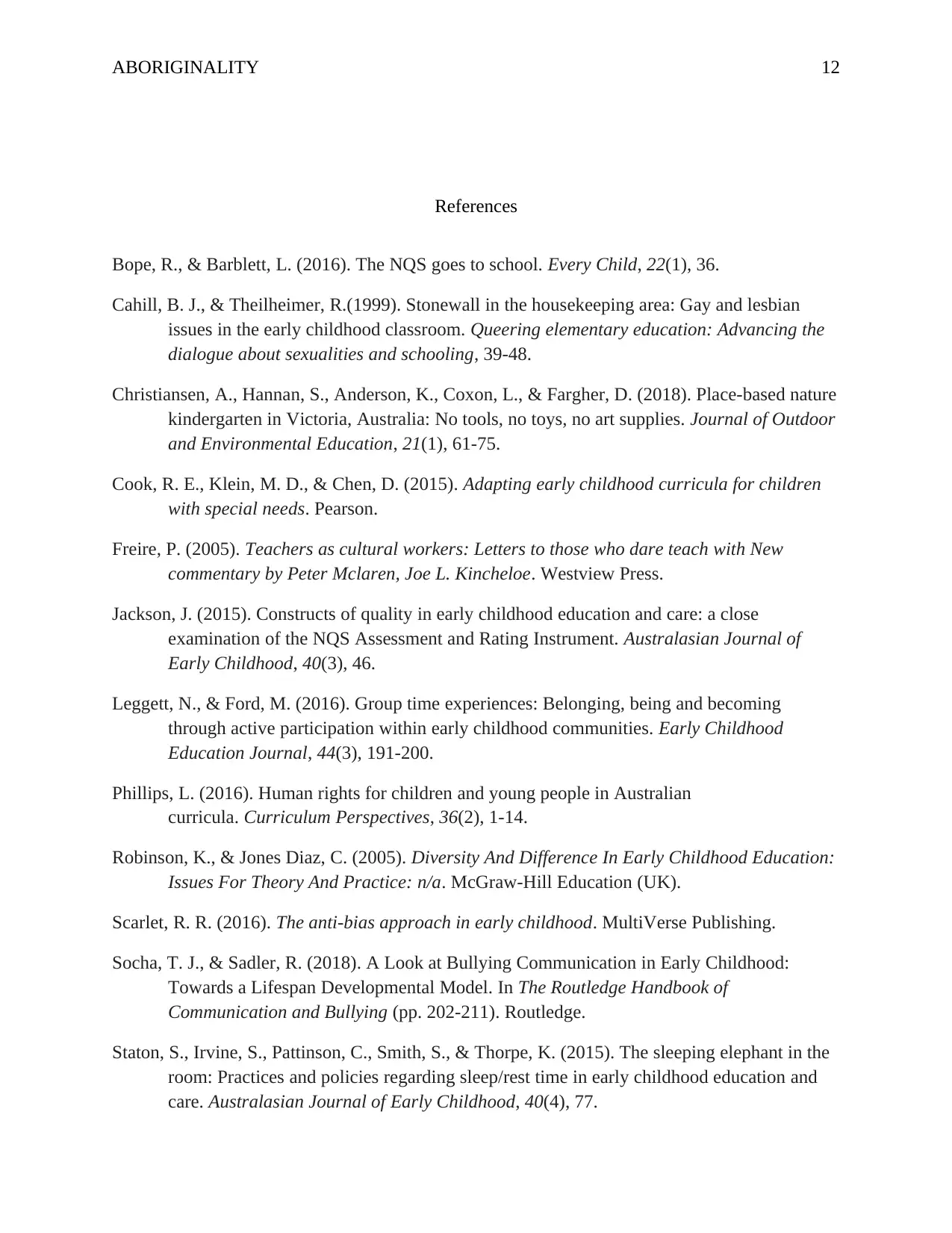
ABORIGINALITY 12
References
Bope, R., & Barblett, L. (2016). The NQS goes to school. Every Child, 22(1), 36.
Cahill, B. J., & Theilheimer, R.(1999). Stonewall in the housekeeping area: Gay and lesbian
issues in the early childhood classroom. Queering elementary education: Advancing the
dialogue about sexualities and schooling, 39-48.
Christiansen, A., Hannan, S., Anderson, K., Coxon, L., & Fargher, D. (2018). Place-based nature
kindergarten in Victoria, Australia: No tools, no toys, no art supplies. Journal of Outdoor
and Environmental Education, 21(1), 61-75.
Cook, R. E., Klein, M. D., & Chen, D. (2015). Adapting early childhood curricula for children
with special needs. Pearson.
Freire, P. (2005). Teachers as cultural workers: Letters to those who dare teach with New
commentary by Peter Mclaren, Joe L. Kincheloe. Westview Press.
Jackson, J. (2015). Constructs of quality in early childhood education and care: a close
examination of the NQS Assessment and Rating Instrument. Australasian Journal of
Early Childhood, 40(3), 46.
Leggett, N., & Ford, M. (2016). Group time experiences: Belonging, being and becoming
through active participation within early childhood communities. Early Childhood
Education Journal, 44(3), 191-200.
Phillips, L. (2016). Human rights for children and young people in Australian
curricula. Curriculum Perspectives, 36(2), 1-14.
Robinson, K., & Jones Diaz, C. (2005). Diversity And Difference In Early Childhood Education:
Issues For Theory And Practice: n/a. McGraw-Hill Education (UK).
Scarlet, R. R. (2016). The anti-bias approach in early childhood. MultiVerse Publishing.
Socha, T. J., & Sadler, R. (2018). A Look at Bullying Communication in Early Childhood:
Towards a Lifespan Developmental Model. In The Routledge Handbook of
Communication and Bullying (pp. 202-211). Routledge.
Staton, S., Irvine, S., Pattinson, C., Smith, S., & Thorpe, K. (2015). The sleeping elephant in the
room: Practices and policies regarding sleep/rest time in early childhood education and
care. Australasian Journal of Early Childhood, 40(4), 77.
References
Bope, R., & Barblett, L. (2016). The NQS goes to school. Every Child, 22(1), 36.
Cahill, B. J., & Theilheimer, R.(1999). Stonewall in the housekeeping area: Gay and lesbian
issues in the early childhood classroom. Queering elementary education: Advancing the
dialogue about sexualities and schooling, 39-48.
Christiansen, A., Hannan, S., Anderson, K., Coxon, L., & Fargher, D. (2018). Place-based nature
kindergarten in Victoria, Australia: No tools, no toys, no art supplies. Journal of Outdoor
and Environmental Education, 21(1), 61-75.
Cook, R. E., Klein, M. D., & Chen, D. (2015). Adapting early childhood curricula for children
with special needs. Pearson.
Freire, P. (2005). Teachers as cultural workers: Letters to those who dare teach with New
commentary by Peter Mclaren, Joe L. Kincheloe. Westview Press.
Jackson, J. (2015). Constructs of quality in early childhood education and care: a close
examination of the NQS Assessment and Rating Instrument. Australasian Journal of
Early Childhood, 40(3), 46.
Leggett, N., & Ford, M. (2016). Group time experiences: Belonging, being and becoming
through active participation within early childhood communities. Early Childhood
Education Journal, 44(3), 191-200.
Phillips, L. (2016). Human rights for children and young people in Australian
curricula. Curriculum Perspectives, 36(2), 1-14.
Robinson, K., & Jones Diaz, C. (2005). Diversity And Difference In Early Childhood Education:
Issues For Theory And Practice: n/a. McGraw-Hill Education (UK).
Scarlet, R. R. (2016). The anti-bias approach in early childhood. MultiVerse Publishing.
Socha, T. J., & Sadler, R. (2018). A Look at Bullying Communication in Early Childhood:
Towards a Lifespan Developmental Model. In The Routledge Handbook of
Communication and Bullying (pp. 202-211). Routledge.
Staton, S., Irvine, S., Pattinson, C., Smith, S., & Thorpe, K. (2015). The sleeping elephant in the
room: Practices and policies regarding sleep/rest time in early childhood education and
care. Australasian Journal of Early Childhood, 40(4), 77.
⊘ This is a preview!⊘
Do you want full access?
Subscribe today to unlock all pages.

Trusted by 1+ million students worldwide
1 out of 13
Related Documents
Your All-in-One AI-Powered Toolkit for Academic Success.
+13062052269
info@desklib.com
Available 24*7 on WhatsApp / Email
![[object Object]](/_next/static/media/star-bottom.7253800d.svg)
Unlock your academic potential
Copyright © 2020–2025 A2Z Services. All Rights Reserved. Developed and managed by ZUCOL.




